Index topics ‘Maritime Analytics Software’
Below you have a quick overview of the different topics discussed in this article. Click one or scroll down to start at the beginning.
- Why is maritime analytics software important today
- No-code maritime analytics software for fast and innovative insights
- Maritime analytics software easily scaling to billions of data points
- Combine multiple data sets for contextual maritime analytics
- Maritime analytics software powered with advanced interactivity
- Share maritime analytics reports, build dashboards, embed
- All-in-one maritime analytics platform
Why is maritime analytics software important today
Maritime transport is the backbone of the global economy with around 90% of international trade volume carried by ships.
Still, the maritime industry is severely challenged. From increased wait times at ports, to illegal fishing, and decarbonization.
However, maritime visibility is possible thanks to global vessel tracking data.
By leveraging maritime analytics software, we’re able to learn and act on vessel tracking data, such as AIS data, to address many of the critical challenges the industry is currently facing.
“I’ve been analyzing AIS data for a long time now and this tool is just incredible with how easy it makes it to not only analyze data but to visualize the analysis as well and to do a dynamic on-demand analysis of very large volumes of data. It’s truly unique in its capability. I’m convinced this tool makes it very easy to get to really valuable information very quickly.”
Mark Deverill, Director Data Operations at Spire Maritime
No-code maritime analytics software for fast and innovative insights
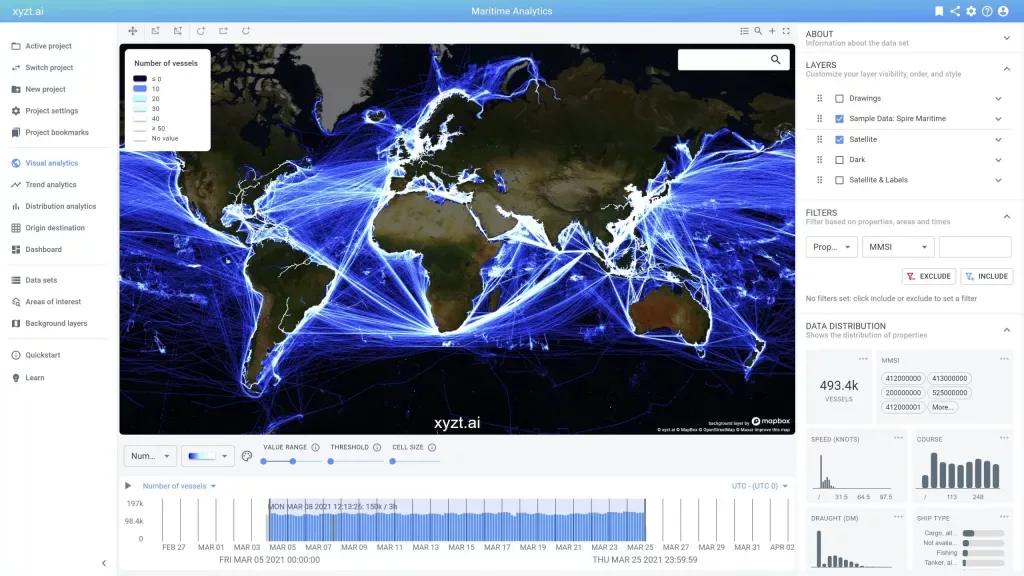
Maritime analytics software empowers data analysts with a self-service analytics platform that requires no coding, specialized knowledge, or custom integrations to perform advanced analytics out of massive amounts of historical and real-time AIS data or any other maritime location data.
Highly-skilled software engineers with years of experience in the location intelligence industry have designed the architecture of xyzt.ai’s maritime analytics platform with “self-service analytics” and “ease of use” as core values.
Once you have your data ready, getting started with a no-code maritime analytics platform is easy. You only need to:
- Connect your AIS data or any other maritime location data to the platform
- Define your areas of interest at the scale of a port, trade route, or the world
- Visually analyze your data with advanced integrated tools
- Share your insights and analytical reports
Why are many companies not benefiting from maritime data?
Maritime data is only as good as the insights you gain from it. Unfortunately, many maritime companies and organizations are not utilizing or fully maximizing the opportunities maritime data analysis offers, because:
- Existing maritime analytics software is too complicated to use
- Building your own maritime data platform requires too much specialized knowledge
- Building your own maritime data tool requires too much time (and budget)
- “I’m not familiar with data analytics, I wouldn’t know where to start”
- …
Rome wasn’t built in a day. There are many complicated steps involved when building your own maritime analytics tool.
- You need to write specialized algorithms.
- You need to visualize and validate the data.
- You need to iterate and improve the process …
Most of all, you need to provide accurate analytical capabilities while visualizing huge amounts of maritime data points. After all, real value comes from analyzing the big picture.
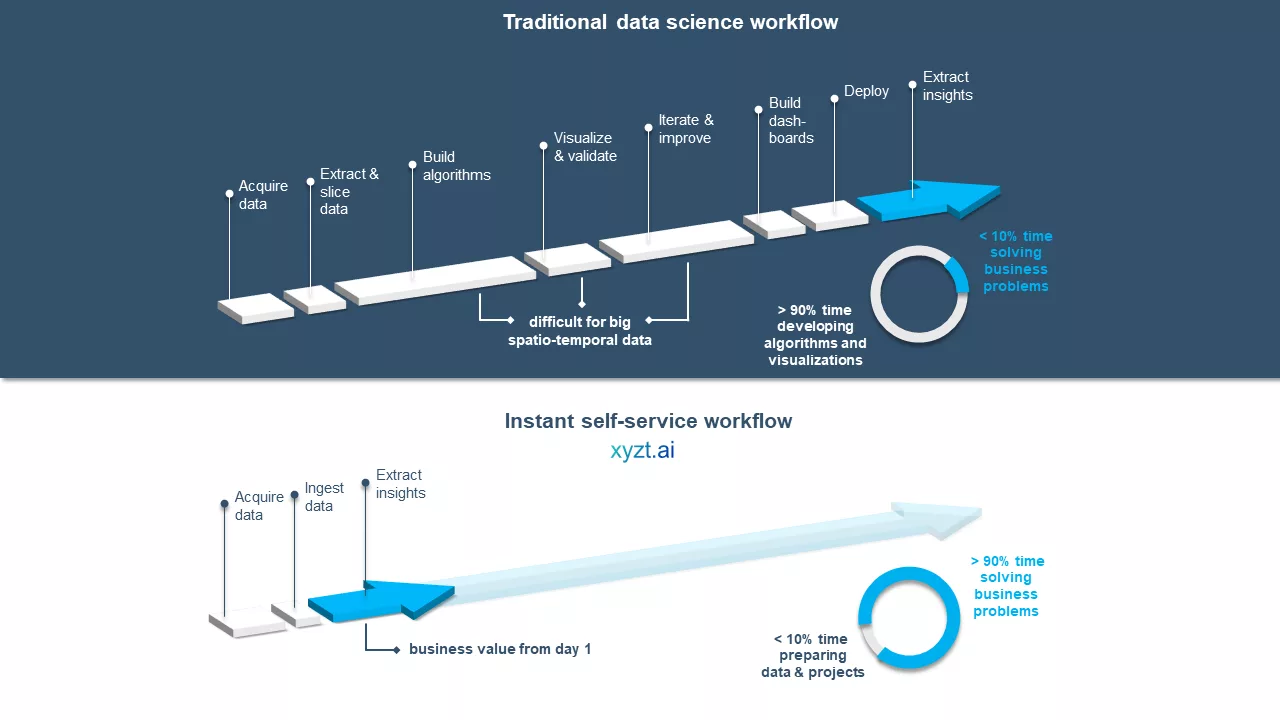
Building your own maritime analytics platform is a time-consuming and expensive task where typically an in-house data science team or an external consultancy company needs to be involved.
A traditional data science workflow requires you to spend 90% of your time developing algorithms and visualizations before you can start discovering value from your data.
A no-code maritime analytics platform uses an instant self-service workflow and eliminates those time-consuming steps.
Now you can spend 90% of your time discovering insights out of your data while only spending 10% doing the preparations.
Maximize your opportunities with no-code maritime analytics software
Ease of use and usability by all are major driving forces behind self-service maritime analytics software. There is no need to code custom algorithms to process and analyze the data, and there is no need to be a data expert to start using all the capabilities the analytics platform offers.
If you have the data, discovering impactful maritime insights is as simple as drag’n’dropping a CSV file into the analytical engine of the maritime data platform.
Maritime analytics software takes care of ingesting, compressing, storing, visualizing, and analyzing your data so that all port authorities, technology companies, and maritime data analysts are able to transform abstract maritime data into concrete and actionable insights from day one.
Maritime analytics software easily scaling to billions of data points
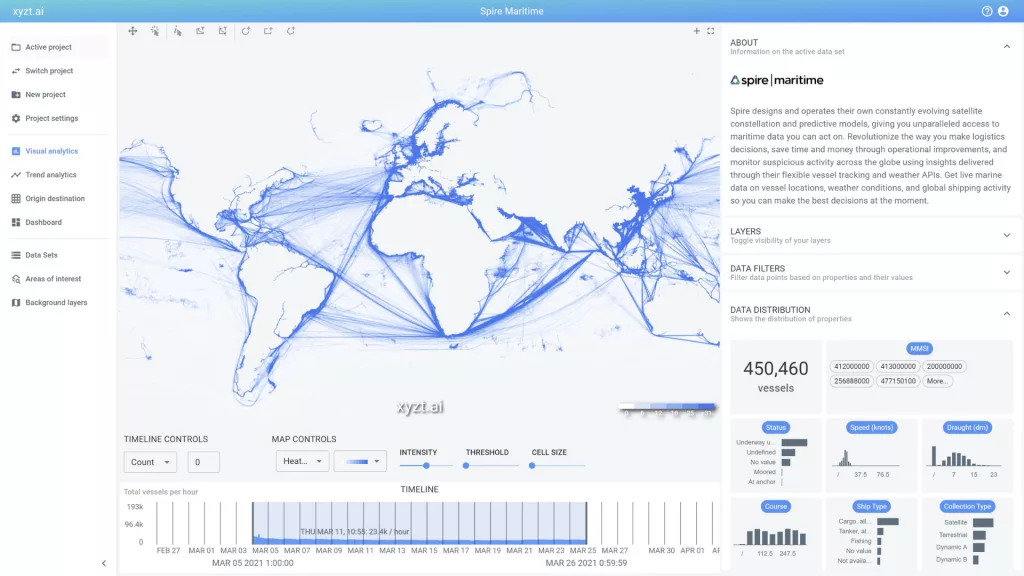
Maritime analytics software provides a future-proof big data visualization and analytics solution that easily scales over one billion maritime data records. Doing so, the platform maintains full capacity of its interactive features at a fast update rate.
Interesting to remember, the maritime analytics platform can be operated through any browser and on any device, eliminating the need for a costly computer with the necessary support for big maritime data analytics.
Meet the need to analyze today and tomorrow
Everyday oceans of maritime AIS data and other vessel tracking data are generated as around 90% of the volume of international trade in goods is transported by ships.
This astonishing number highlights the critical importance of safe and sustainable maritime transport to support international trade and the global economy.
As a result of the instant availability of vessel tracking data and the rapid increase in the use of Internet-of-Things technology, maritime companies are presented with huge opportunities to leverage data analytics and discover business intelligence to create more maritime visibility, efficiency, and safety.
Digital transformation has already begun and because the data to monitor, learn, and improve is here today, you are at risk of missing the boat (pun intended).
However, the real value lies behind the macro picture. To discover impactful insights, maritime data analysts need to be armed with a powerful tool capable of visualizing and analyzing the data generation of today and tomorrow.
Data from one vessel journey will tell us something, but billions of AIS data records inform us about global trade flows and yearly trends from fleet monitoring, congestion analysis, competitive analysis, and a lot more.
Customers of our maritime analytics platform are already dealing with huge data sets and will do so even more in the future.
Visualize the big picture with future-proof and scalable maritime analytics
A powerful maritime analytics platform secures port authorities, maritime technology companies, shipbuilders, and other industry companies with a future-proof and scalable maritime analytics tool capable of leveraging billions of data points from any type of maritime location data.
This includes AIS data, radar data, satellite data, time series data, weather data, and much more.
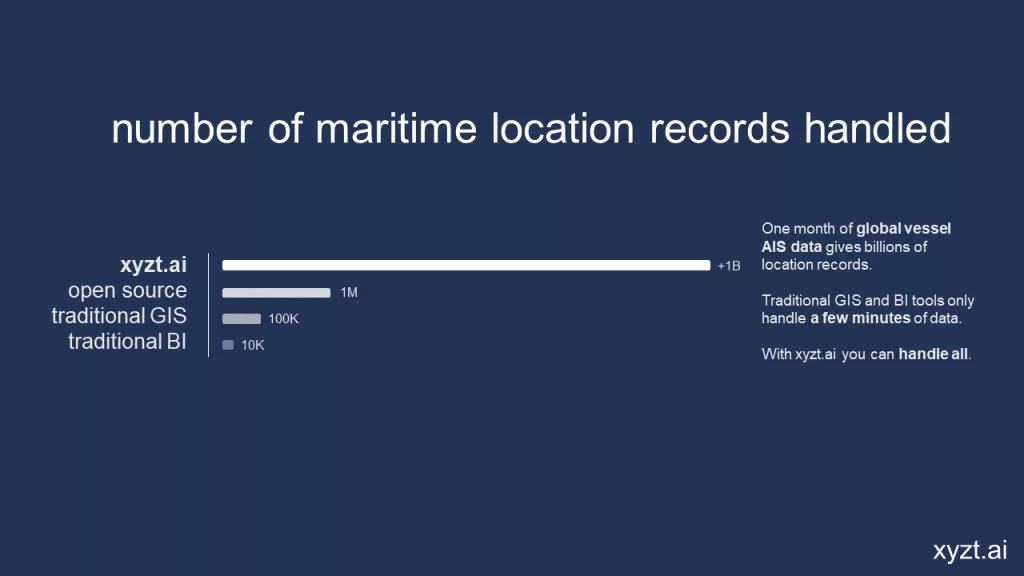
Traditional GIS and open-source data analytics tools can’t handle the maritime data volume of today. They quickly crash, they don’t provide the necessary interactivity, and they force the analyst to upload the data in pieces for fragmented analysis.
Visualizing the big picture should be the standard for any maritime data analyst.
The scalable architecture of a powerful maritime analytics software enables the data analyst to
- Visualize months of any maritime location data
- Step beyond the visualization part to perform advanced analytics at a macro or micro scale.
Using a maritime analytics tool, the analyst can analyze at global scale or zoom in on ports, trade routes, or your competitor to perform local analytics.
Combine multiple data sets for contextual maritime analytics
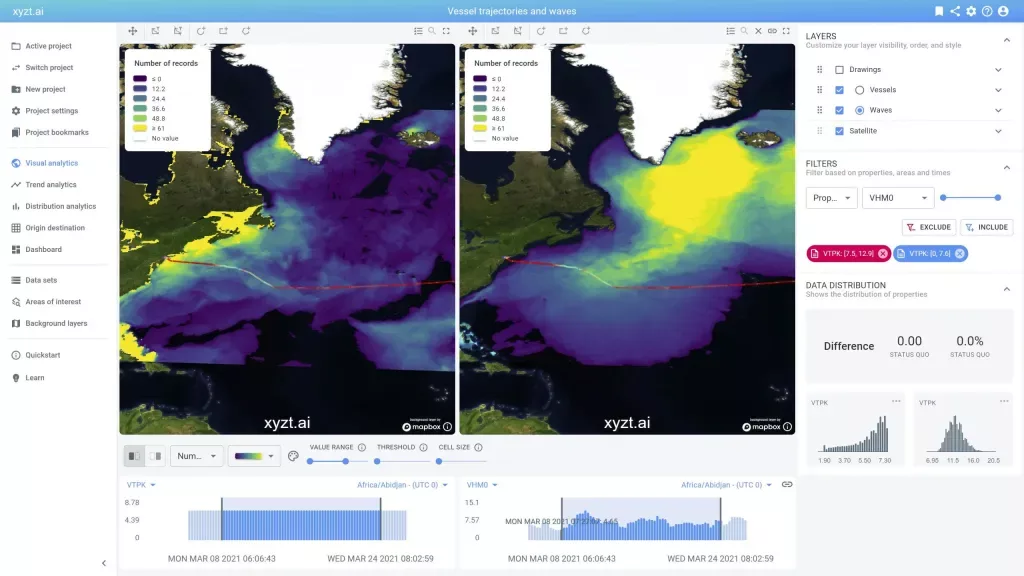
Maritime analytics software enables data analysts to understand the maritime sector and its impact on the world by combining multiple data sets, such as AIS data, time series data, radar data, ocean wave data, weather data, and more.
The ability to put data into context has never been more important than today. Adding multiple data sets and creating a layered analytical experience has become an invaluable feature for maritime data analysts to gain a wider understanding of what maritime transport means and what impact it has on the world.
Bring your own data and create context
The data agnostic character of flexible maritime analytics software enables data analysts to bring their own data (BYOD) or visualize any maritime data acquired from providers, such as Spire Maritime, Orbcomm, Saab, and others. The data platform adapts to any spatial-temporal data as long as it contains an identifier, location, and timestamp.
This flexibility casts a wide net of leverageable data sources and creates unique opportunities for the data analyst to gain contextual maritime insights by not only analyzing vessel tracking data, but by combining it with ocean wave data, weather data, and more.
By providing unparalleled processing of all maritime location data types, xyzt.ai’s maritime analytics platform empowers data analysts with a scalable and interactive tool capable of bringing all the maritime data together in one picture to perform layered analytics customized to the needs of the analyst.
Maritime analytics software powered with advanced interactivity
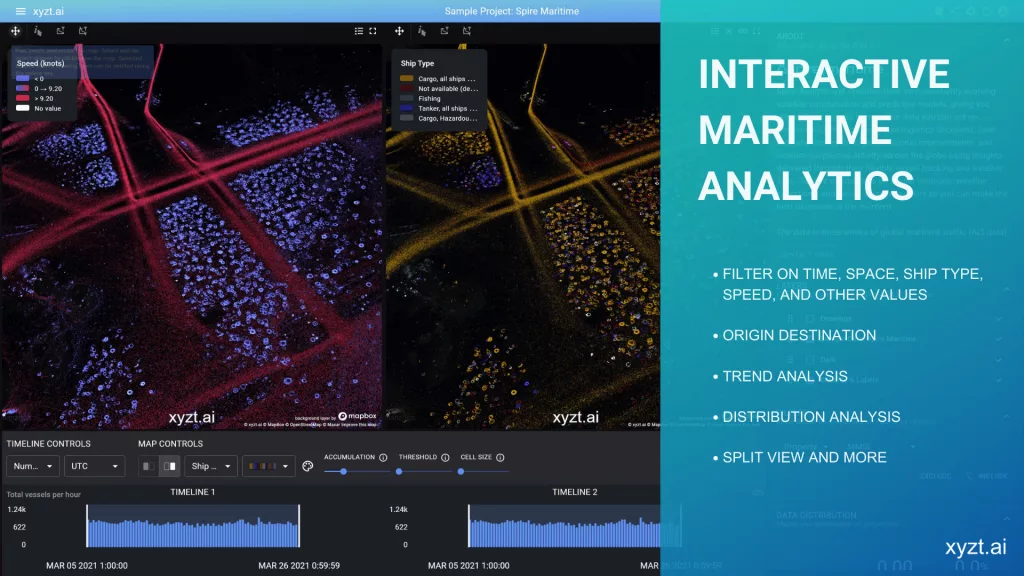
Maritime analytics software steps beyond data visualization. It provides advanced analytical tools that offer detailed interactivity at a fast-update rate for maritime analysts to gather insights out of billions of maritime data records.
Visualizing the big picture is the first step towards extracting real business value, but the capability to dig in the data and to perform dynamic on-demand analysis is key to obtain valuable information quickly.
All analytical tools of the platform are designed to extract the most value out of maritime data and tailored to meet the requirements of every maritime data analyst.
Get the most out of your data with advanced interactive analytics
The main analytical feature of the maritime analytics platform is called the Visual Analytics page.
This page is where maritime data analysts will spend most of their time. It offers three different, but interconnected, views on the same data set. Each view enables the data analyst to interact with and filter the data according to the analytical requirements.
- Heatmap: This screen visualizes total coverage of the maritime data set. It’s able to process billions of AIS data records with a sub-second update rate while maintaining interactivity. For example, by zooming in and out on the map.
- Timeline: Using this view, the data analyst can filter and analyze the data set within a chosen time range. A histogram displaying a chosen value, such as number of records, is plotted on top of the timeline.
- Distribution panel: The third view shows the distribution of different properties, such as speed and total distance, found in the data set.
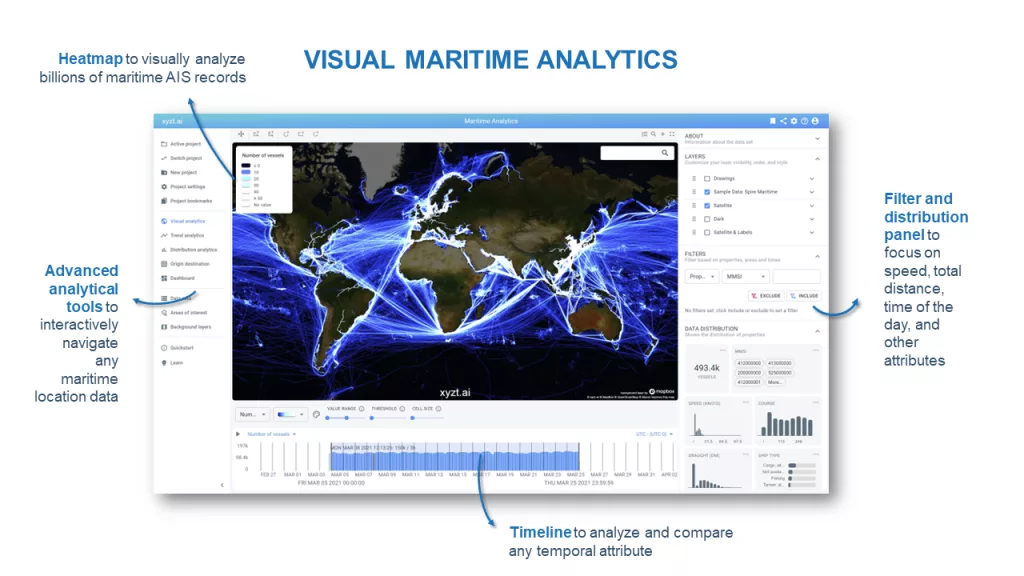
Important to remember! As all three views are interconnected, any interactivity you engage with on a particular view will have an impact on all views.
For example, if you adjust the timeline to select only the first two days of a week’s worth of data, then your heatmap will display less data and the distribution panel will also update accordingly.
Customized analytical tools for all types of maritime use cases
Users of the maritime analytics platform benefit from a wide range of additional built-in analytical tools, such as:
- Origin Destination Analysis: Instantly visualize how much vessel traffic is moving between your chosen areas of interest with the help of beautiful matrices.
- Trend Analysis: Easily analyze trends and differences found in the data over any time period.
- Distribution Analysis: Dive into the attributes of the data, such as speed and ship type, to understand what is happening at a certain point in time.
- Or thin out the data by filtering based on your areas of interest, time, or any data attribute.
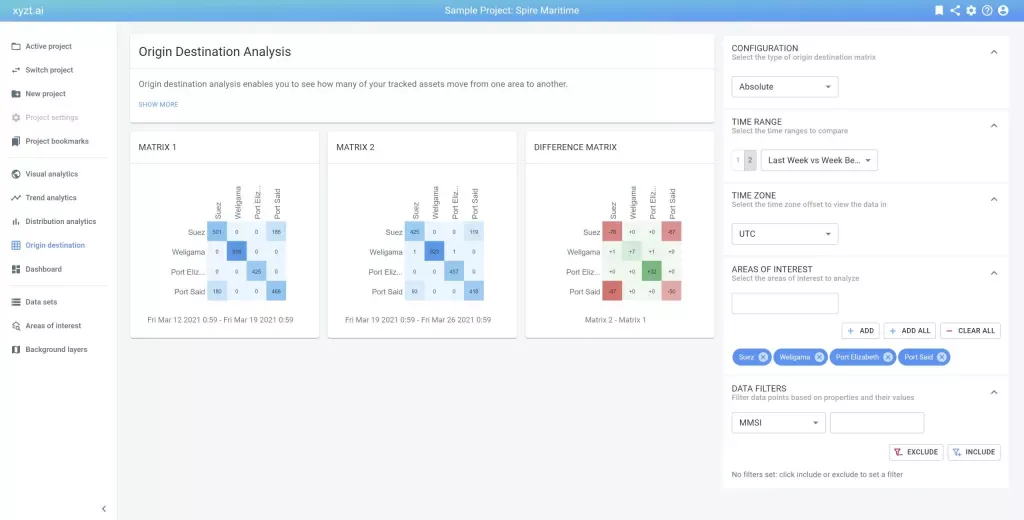
The maritime analytics platform brings a unique edge to the market as it unites scalability and interactivity. Even more, your computer doesn’t require powerful computational power to interactively analyze billions of maritime data records. You can use a normal computer, your smartphone, or any device.
Share maritime analytics reports, build dashboards, embed
Maritime analytics software enables you to interactively share your data visualizations and analytical discoveries with the world. Build beautiful dashboards and analytical reports to share them with colleagues, prospects, stakeholders, or with anyone you like.
Whether you need to create an analytical report for an internal presentation, pitch an idea to prospects, inform your stakeholders, send an article to the press, or if you want to use your data visualizations for marketing purposes, the essence remains the same.
The ability to properly explain what you’re doing and what you have discovered is as important as your analysis itself.
How to interactively share your insights and deliver a convincing message
There are a couple of ways you can share what you’re doing with your data on the xyzt.ai maritime analytics platform.
Firstly, as explained in further detail in the chapter ‘Advanced Interactivity’, the xyzt.ai analytics platform provides different analytical pages where the analyst can perform specialized tasks to dive deeper into the data and extract specific insights.
Using a special link, that you can generate at any time, you’re able to share your visualizations and insights from all analytical pages available on the xyzt.ai maritime analytics platform. These include Visual Analytics, Trend Analytics, Origin Destination Analytics, and Distribution Analytics.
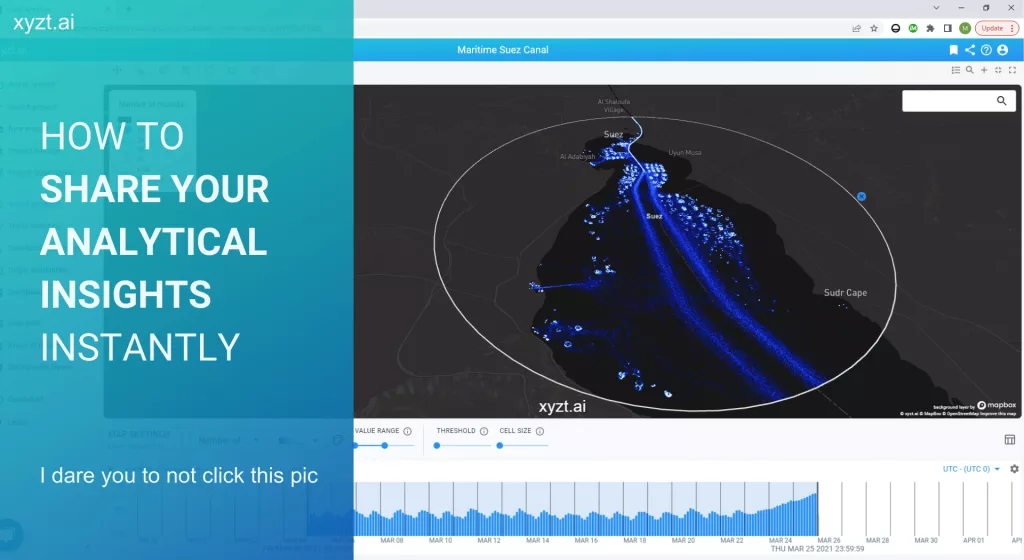
When you share your special link with a colleague, prospect, or the press, they can see your maritime data visualizations just like they would if they were users of the platform themselves.
They are also able to interact with the data and the platform to gain a better understanding of what they are looking at. For example, by zooming in and out on the heatmap or by filtering on the timeline.
However, you stay in full control deciding with who you wish to share your special link and for how long it remains active. People can’t access your data and if you deactivate the link, nobody will be able to see your visualizations and analysis generated through that link.
Data has many stories to tell … Start building yours!
A second way to share your insights is by using an embed code that enables you to integrate and visualize data stories and insights in an interactive way into your own platform, website, or blog post.
Just as with the shared link, you can apply the embed code for any analytical page on the maritime analytics platform.
Thirdly, and most importantly, you’re able to construct data stories and analytical reports by building beautiful interactive dashboards with widgets displaying maps, timelines, bar charts, or any other specialized analytical tool the maritime data platform offers. And of course, you can share or embed your dashboard to communicate your story.
People understand things a lot better and faster if we present them in a visually appealing way.
Sharing your insights and analytical reports using a special link or an embed code simplifies how you wish to communicate your data story and empowers you to deliver a convincing message to your stakeholders, customers and prospects, or to the press.
All-In-One Maritime Analytics Software Platform
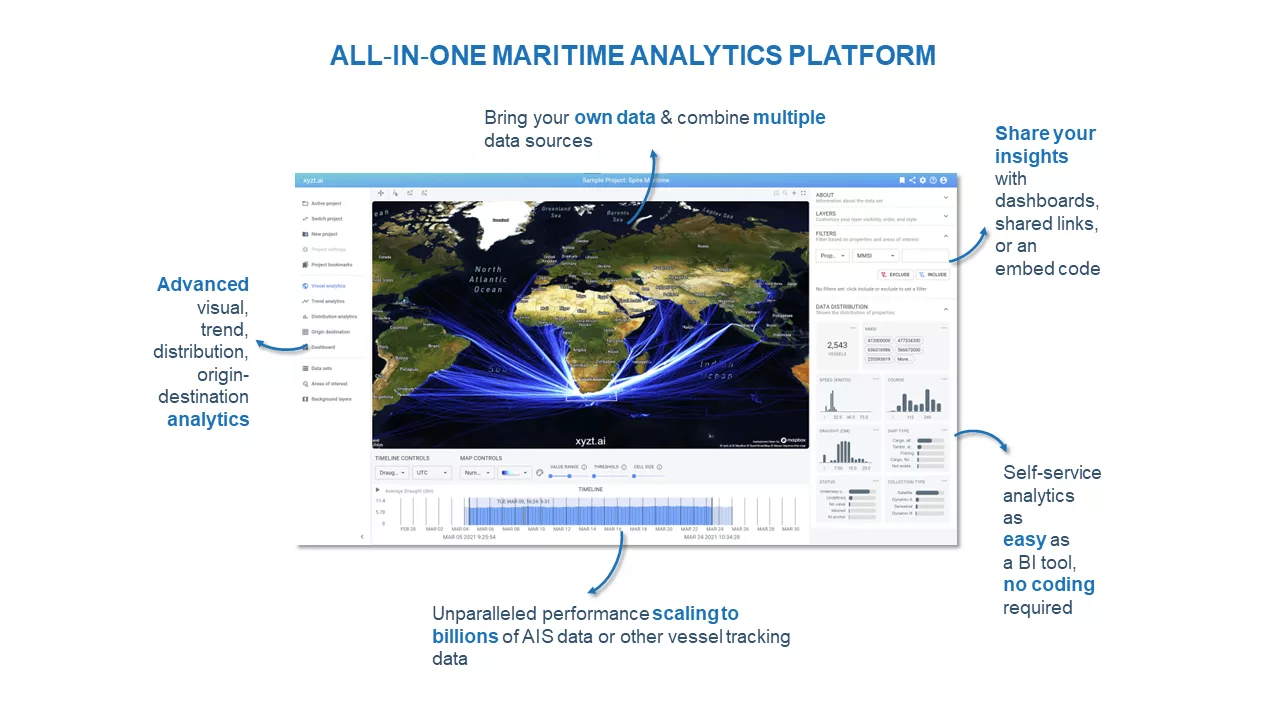
Maritime analytics software brings the most essential data visualization capabilities and analytical features for data analysts together in one accessible and powerful platform that cuts back time to insights from months to minutes.
During each chapter of this article, we have expanded on separate features that we believe are vital to strengthen the capabilities of maritime data analysts.
We believe each feature empowers analysts to gain a better understanding of their data and to make better use of their time.
All essential analytical features combined in one platform
Here is a quick summary of the most important features of xyzt.ai maritime analytics software.
- Self-service maritime analytics requiring no coding or specialized knowledge to get started.
Avoid writing specialized scripts and other time-consuming steps involved with maritime data analytics. There is no need to reinvent the wheel. Make sure that anyone can discover insights from data without needing to be a data scientist. - Powerful platform scaling to over a billion location records.
Real value comes from analyzing the big picture. As AIS data and IoT devices are steering the maritime digital transformation, you need to be able to handle the current and future data generation. You can’t rely on an open-source tool that crashes after visualizing 1 GB of data. - Bring your own data and combine multiple data sets
As long as your maritime data contains a location and a timestamp, then xyzt.ai’s maritime analytics platform is compatible with any data you have collected yourself or bought from data providers, such as Spire Maritime, Orbcomm, FleetMon, and any others. - Navigate your data with advanced interactivity and various analytical pages
Step beyond visualization. Perform dynamic on-demand analysis using a wide array of advanced analytical features that enable you to dig in the data and extract the insights you need. - Share your insights and analytical reports with dashboards, shared links, or an embed code
People are visual. Whether you need to create an analytical report for internal purposes, pitch an idea to prospects, inform your stakeholders or the press, or use it for marketing purposes, people will always understand best if you can share your insights in a visually appealing way.
Even though each feature on its own provides an interesting vantage point and adds great value to the toolkit of a data analyst, the real magic happens when they are brought together and are accessible in one platform.
One big data analytics platform for the maritime industry
The inspiration to bring everything together and create an all-in-one analytics platform leads to the idea and architecture behind xyzt.ai’s maritime analytics software.
The founders of xyzt.ai are veterans of the location intelligence industry who experienced many companies deal with challenges centered around accessibility, scalability, and interactivity in the maritime analytics industry.
They noticed a lot of companies couldn’t benefit from big data analytics because it wasn’t accessible enough without them needing to hire specialized team and spend a big budget.
Therefore, Lida Joly and Bart Adams have carefully thought out how to equip maritime data analysts with a powerful self-service analytical tool that scales to the vast amounts of maritime data generated today and can be used by anyone.
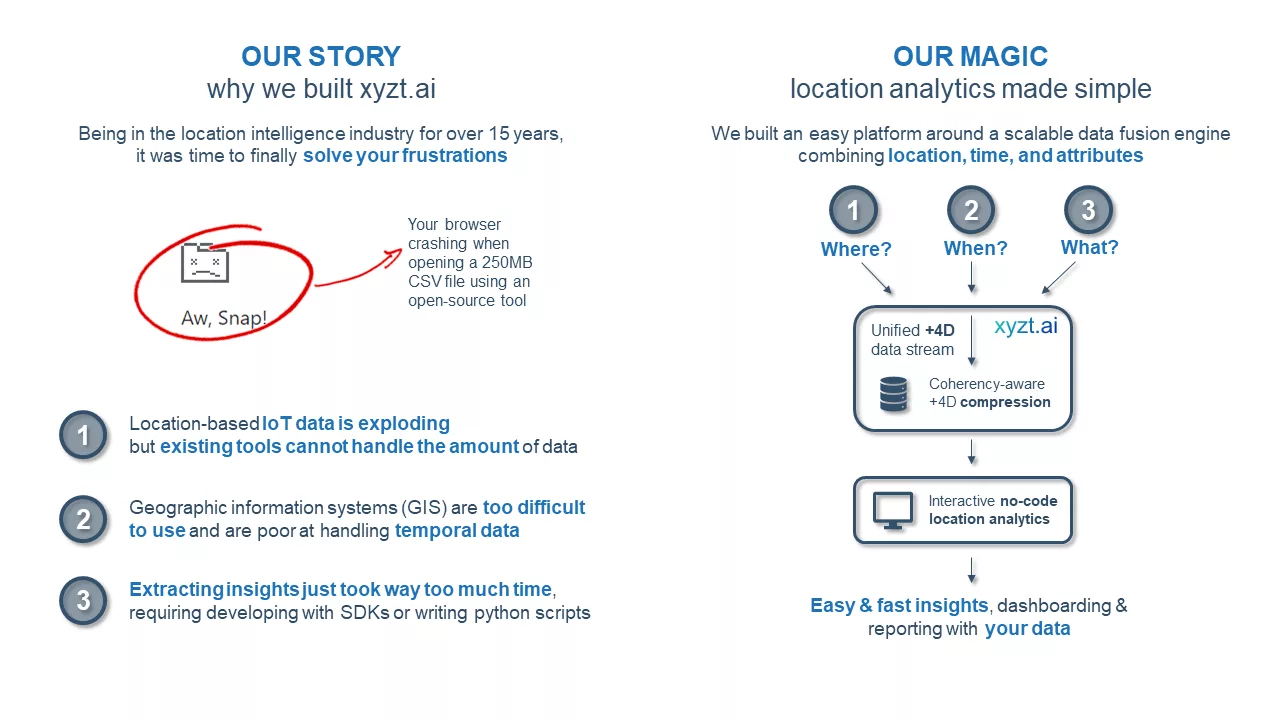
Most maritime data platforms can’t scale to hundreds of millions, let alone to billions of location records.
Most analytical tools can’t provide responsive interactivity with big data, let alone provide advanced analytical features such as trend analytics and origin-destination.
Most analytical software can’t be operated without specialized knowledge, let alone for anyone to go from uploading data to extracting insights in one day.
Most platforms don’t allow you to bring your own data, let alone combine other location data on top of each other.
Most importantly, no maritime analytics platform provides all the above together in one platform and adds the sharing of analytical reports as the final piece of the puzzle.
By bringing these essential features together, xyzt.ai’s maritime analytics software provides a unique analytical experience that equips analysts with everything they need to gather intelligence from any type of maritime data for any type of use case.

